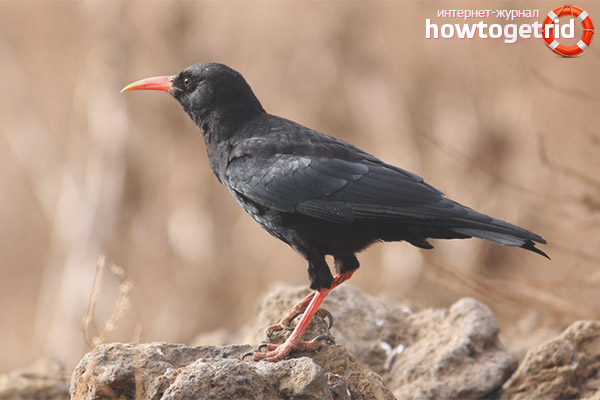The content of the article
Klitschitsa is an interesting species of birds that captivates attention with its behavior during the mating season. Especially spectacular flights of these birds at a time when klushitsy perform acrobatic stunts, inconceivable in their complexity and beauty (upheavals, turns, sharp drops down and the same sharp soars up). Note that today the population of this species is small, due to its sharp decline over the past few decades.
View description
The feather cover of adult males is black and shiny. In young representatives of this species, the plumage has a more matte shade, the feathered beak is yellowish-brownish.
In flight, the nymphs are distinguished by their excellent lightness and maneuverability; in the air, fly feathers are quite widely spread, so that these birds have good flight capabilities. Often you can see a single flight of a nestling bird or a small group of these birds flying at fairly high speed past the rocks, which suddenly gain height, after which they abruptly rush down, performing intricate aerial figures. As a rule, in flight, representatives of this species often emit loud and sharp shouts of “kra-kra”.
The closest colony of nests is located in the Alps (south and west of this mountainous area). Also, a small population of the species lives in the UK and Ireland. Most often, these birds choose abandoned mines, mines, and quarries for nesting.
In size, the nub is no larger than an ordinary jackdaw. Note that it is the jackdaws (directly such a species as the alpine jackdaw) that are the closest related species, which differs from the claws in a shorter yellow beak.
Habitat and lifestyle
As a rule, nests in the highlands rarely go down, this is because living in the highlands gives these birds everything they need for life and food. The peculiarity of this species is that birds spend most of their lives in the air. Over the places of their nesting males perform complex dances, attracting the attention of their girlfriends.
Despite the fact that the nestling is a flock of birds, representatives of this species are often kept in family groups consisting of several birds or in pairs. The members of such a group actively protect the family territory from attacks by other birds, which is manifested not only by rather aggressive behavior towards strangers, but also by a warlike appearance - ruffled plumage and screams emitted by means of a wide open beak.
Power Features
This kind of bird as a naughty bird is not too picky about food. In some areas, these birds mainly feed on food found in landfills. The main diet is invertebrates, small insects, fruits and seeds of plants. The nest collects part of the food necessary for food near the nesting site, and for the rest rises high in the mountains.
Most often, to search for food, this small bird chooses places covered with low, but at the same time dense vegetation (meadows, well-lit glades, fields). In order to find your favorite treat in the form of invertebrates and small insects, the naughty woman often turns over small pebbles, delves into heaps of manure. Also, through their rather long beak, these birds are able to explore the soil in search of larvae of various insects and worms. In the cold season, most birds choose the sea coast as a place to search for food, where they collect sea vegetation carried ashore.
Breeding
The nesting season of nests occurs with the arrival of heat. Toxing of this species of birds occurs both on the ground and in the air. In flight, these birds demonstrate their exceptional flying abilities, which is manifested by the implementation of intricate acrobatic stunts that really take your breath away (complex upheavals, rapid ups and downs, graceful steps and much more).
Often, one female has several fans at the same time, who try to outdo each other to please the object of sighing. After mating, the representatives of the couple look after each other, which is manifested by the mutual cleaning of the feather cover. Often a male brings a variety of goodies to his girlfriend.
To build their nest, birds often choose secluded and inaccessible places (crevices, rocky ledges). The number of eggs in this clutch does not exceed 5 pcs. The female is engaged in hatching offspring, the male is at this time engaged in providing food to his girlfriend. They feed the chicks that were born - both parents. Already after 6-7 weeks after hatching, young individuals become winged and ready for independent life.
Interesting Facts
- The main natural enemy of the nest is a bird of prey such as a peregrine falcon.
- Klaritsa is a bird species that nests at high altitudes. For example, in the Himalayas, these birds equip nests at a height of not less than 500 m above sea level. To find the necessary food, they can rise even higher.
- Having found a sufficiently large amount of food, nippers often make stocks for good, leaving food in different secluded places.
Video: naughty girl (Pyrrhocorax pyrrhocorax)











Submit